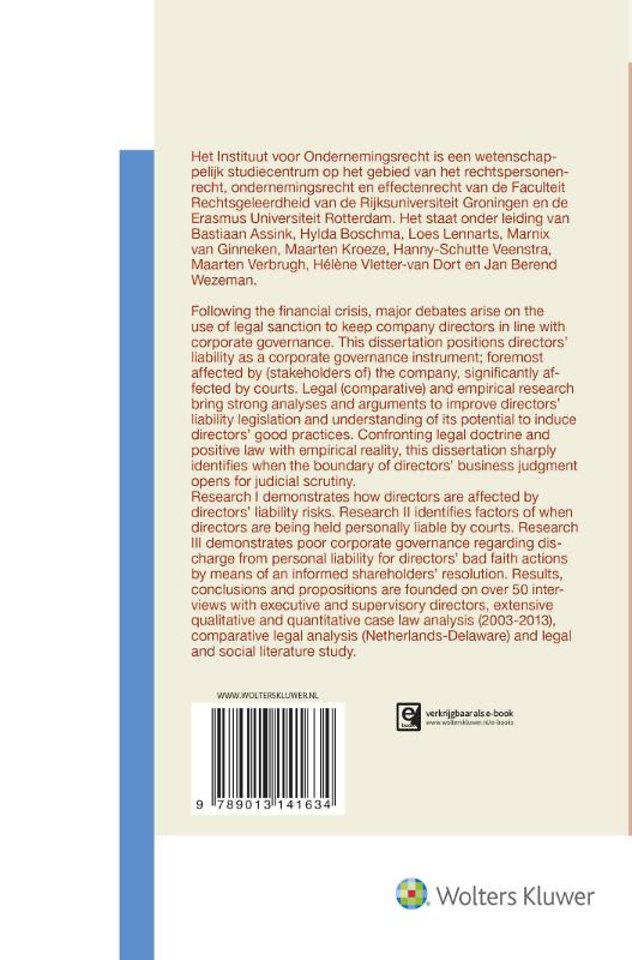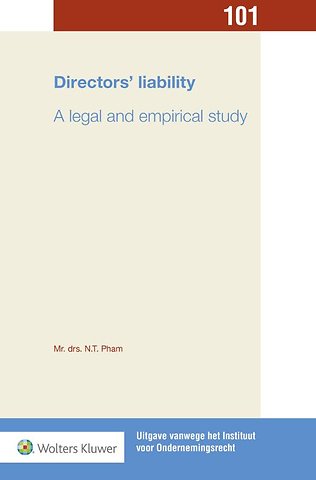Directors' liability
A legal and empirical study
Samenvatting
English
The financial crisis has intensified a fierce discussion on the question of what is needed to compel businesses to adhere to good corporate governance. In this doctoral dissertation Thy Pham argues for directors’ liability as a corporate governance instrument with a twofold effect: to increase correct behaviour and to sanction culpable conduct.
When is a risk still sound and when is it irresponsible? Where do we draw the line? Directors do not only differ on this issue itself, but also act on it at their own discretion. This makes directors’ liability all the more important. As an instrument, it may not prevent directors from wrongdoing, but it can ensure that, if discovered and identified, these directors do not go scot-free. Implementing legal sanctions against such directors may foster trust in business. Moreover, it may foster trust in the legal system.
The legislation pertaining to directors’ liability has two objectives: allocation of damage and controlling behaviour. In Directors’ liability the focus is on controlling behaviour. Pham hereby relinquishes the traditional legal view of directors’ liability as predominantly regulative and coercive. “The point is that directors’ liability is understood to be an intricate system of sanction and protections and to consider the explicit and latent characteristics of directors' liability.” Whereas most legal literature shies away from supplementary empirical research, Pham combines comparative legal studies, social scientific literature as well as extensive empirical investigation - and convincingly so. Her efforts have rendered valuable, new legal and empirical insights in the behavioural dimension of directors’ liability.
If you are a director, corporate lawyer, lawyer, judge, policymaker or scientist, Pham approaches the issue of directors’ liability also from your specific perspective. Her doctoral dissertation includes chapters on:
-the concrete factors on the basis of which directors can be held liable (highly relevant to directors, corporate lawyers and lawyers)
-reference points for the streamlining and substantiation of court decisions (added value for judges)
-the effects of directors’ liability law on their conduct (added value for judges)
-clues for influencing conduct through liability (very relevant to policymakers)
Each chapter illustrates not only how legal and empirical research can be combined, but also how legal and social scientific literature can be brought together (interesting for scientists).
Directors’ liability A legal and empirical study was supervised by Professor B.F. Assink, Professor L. Timmerman and Dr T.F.C. Fischer. They describe Pham’s dissertation as ‘multidimensional, thorough and innovative. It contains strong analysis and arguments’.
Nederlands
De financiële crisis heeft een felle discussie aangewakkerd over wat er nodig is om corporate governance, oftewel goed ondernemingsbestuur, bij ondernemingen af te dwingen. In dit proefschrift positioneert Thy Pham bestuurdersaansprakelijkheid als een door stakeholders en rechters beïnvloed corporate governance-instrument. Met een tweeledige werking: bevordering van correct gedrag en sanctionering van verwijtbaar gedrag.
Wanneer is een risico nog een verantwoord risico en wanneer niet meer? Waar ligt die scheidslijn? Bestuurders denken daar niet alleen verschillend over, maar handelen er ook verschillend naar. In die context speelt bestuurdersaansprakelijkheid een belangrijke rol. Bestuurdersaansprakelijkheid zal bestuurders er niet van weerhouden om misstanden te begaan, maar het kan er wel voor zorgen dat zij niet vrijuit gaan. Het aansprakelijk houden van deze bestuurders kan het vertrouwen in het rechtssysteem bevorderen.
Het bestuurdersaansprakelijkheidsrecht heeft twee functies: schadeallocatie en controle van gedrag. In Directors’ liability ligt de focus op de controle van gedrag. Pham verlaat hierbij de traditionele juridische kijk op bestuurdersaansprakelijkheid als overwegend regulerend en dwingend. “Bestuurdersaansprakelijkheid moet worden opgevat als een complex systeem van sanctionering en bescherming ineen, waarbij de expliciete en latente kenmerken van bestuurdersaansprakelijkheid in aanmerking moeten worden genomen.” Waar in de meeste juridische literatuur geen gebruik wordt gemaakt van aanvullend empirisch onderzoek, combineert Pham rechtsvergelijkend onderzoek, sociaalwetenschappelijke literatuur én uitgebreid empirisch onderzoek overtuigd met elkaar. Het resultaat daarvan levert waardevolle, nieuwe en empirische inzichten op in de gedragsmatige dimensie van bestuurdersaansprakelijkheid.
Bent u bestuurder, bedrijfsjurist, advocaat, rechter, beleidsmaker of wetenschapper? Pham benadert bestuurdersaansprakelijkheid mede vanuit uw specifieke invalshoek. Zo leest u hoofdstukken over:
-concrete factoren om bestuurders aansprakelijk te stellen (extra relevant voor bestuurders, bedrijfsjuristen en advocaten)
-aanknopingspunten om rechterlijke beslissingen te stroomlijnen en te motiveren (meerwaarde voor rechters)
-de wijze waarop bestuurdersaansprakelijkheidsrecht uitwerkt op het gedrag van bestuurders (meerwaarde voor rechters)
-aanknopingspunten om gedrag te beïnvloeden d.m.v. aansprakelijkheid (extra relevant voor beleidsmakers)
Elk hoofdstuk illustreert hoe juridisch en empirisch onderzoek met elkaar kunnen worden gecombineerd. Én hoe juridische en sociaalwetenschappelijke literatuur aan elkaar worden gelinkt (interessant voor wetenschappers).
Trefwoorden
Specificaties
Inhoudsopgave
Chapter 1. A window on the research 1
1.1 The motivational basis of the research 1
1.1.1 To punish and not to punish 2
1.1.2 Recognising the dimensions of directors’ liability legislation 3
1.1.3 The importance of legal sanction 5
1.2 What this book is (not) about 7
1.3 Structure 8
References 10
Chapter 2. Defensive behaviour as good corporate governance?
A case study 13
2.1 Introduction 13
2.2 Literature review 14
2.2.1 Directors’ liability as a corporate governance instrument 14
2.2.2 Defensive behaviour 16
2.2.2.1 Defensive behaviour in Dutch case law 17
2.2.2.2 Defensive behaviour in business 18
2.2.2.3 Understanding defensive behaviour better 19
2.3 The research 19
2.3.1 Research questions 19
2.3.2 Research method 21
2.3.3 Data collection 22
2.3.3.1 Interviews 22
2.3.3.2 Analysing corporate documents 23
2.3.3.3 Participants and company characteristics 24
2.3.3.4 Analysing media reports 24
2.3.3.5 Analysing court decisions 25
2.3.3.6 Interviewing legal counsels, insurers and risks advisors 25
2.4 Findings 26
2.4.1 Do senior directors fear directors’ liability risks? 26
2.4.2 When do senior directors resort to defensive practices? 27
2.4.2.1 Fraud 27
2.4.2.2 Bankruptcy 29
2.4.2.3 Individual experience 30
2.4.3 Is defensive behaviour problematic? 31
2.4.4 Does director liability protection reduce the tendency to behave defensively? 32
2.4.4.1 Exoneration 32
2.4.4.2 Directors’ and Officers’ Liability insurance and indemnification 34
2.4.4.3 Directors’ liability legislation 36
2.5 Discussion 38
2.6 Conclusion 41
Appendix I 43
Appendix II 47
References 48
Chapter 3. How courts determine directors’ liability. A jurimetrics study 55
3.1 Introduction 55
3.1.1 Research issue: predicting directors’ liability on the basis of open norms 55
3.1.2 Research question 56
3.2 Directors’ liability and legal certainty: a qualitative analysis 57
3.2.1 The (un)problematic nature of the open norm: serious reproach 57
3.2.2 Internal directors’ liability – article 2:9 DCC 60
3.2.3 Liability for wrongful acts – article 6:162 DCC 61
3.2.4 Liability in the event of bankruptcy – article 2:138/248 DCC 63
3.2.5 Formalising ‘serious reproach’ 65
3.3 Analysing court decisions quantitatively 67
3.3.1 Focus of quantitative analysis using Dutch court cases (2003-2013) 67
3.3.2 The data: characteristics and selection 67
3.3.3 Coding dependent and independent variables 70
3.3.4 Statistical analysis plan 72
3.4 Research results 74
3.4.1 Which behavioural and contextual legal case factors have a significant effect on directors’ liability? 74
3.4.2 Intermezzo: understanding subjective bad faith as a dependent variable 77
3.4.3 Which behavioural and contextual legal case factors have a significant effect on directors’ liability in cases not involving directors’ ‘subjective bad faith’? 80
3.5 Discussion 83
3.5.1 Interpreting the research results 83
3.5.1.1 Directors’ ‘subjective bad faith’ 84
3.5.1.2 ‘Foreseeability of damage’ and ‘norm violation’ 85
3.5.1.3 Contextual legal case factors 86
3.5.1.4 Legal case factors that did not occur in the prediction model 86
3.5.2 Quality of the regression model 87
3.5.2.1 Reliability 87
3.5.2.2 Internal validity 88
3.5.2.3 External validity 88
3.6 Concluding remarks & further research 89
Appendix I 90
Appendix II 93
References 99
Chapter 4. Rethinking discharge from directors’ liability. Using comparative and empirical insights 103
4.1 Introduction 103
4.1.1 Research issue: understanding a waiver of rights in the light of good corporate governance 103
4.1.2 Research question 105
4.1.3 Comparative and empirical insights 105
4.1.3.1 Delaware as a source of inspiration 106
4.1.3.2 Looking at discharge claims empirically using Dutch court cases (2003-2013) 109
4.2 Delaware exculpatory provision 110
4.2.1 Section 102(b)(7) DGCL: framework 110
4.2.2 Empirical insights 112
4.2.3 Section 102(b)(7) DGCL as a device to dismiss claims 115
4.2.4 Section 102(b)(7) DGCL as an affirmative defence 118
4.2.5 No liability protection for ‘subjective bad faith’ or ‘not in good faith’ actions 119
4.3 How Dutch law differs from Delaware law 124
4.3.1 Discharge from directors’ liability: the framework 124
4.3.2 Empirical insights: the courts’ review of discharge claims 127
4.3.2.1 Did the general shareholders’ meeting grant discharge? 128
4.3.2.2 Did the litigious actions fall under the scope of the discharge? 129
4.3.2.3 Were the litigious actions qualified as ‘subjective bad faith’ actions? 130
4.3.2.4a ‘No subjective bad faith’ ≠ liable 131
4.3.2.4b ‘No subjective bad faith’ = liable, hence ‘not in good faith’ 133
4.3.3 Summary 135
4.4 Rethinking discharge from directors’ liability 136
4.4.1 Interpreting directors’ ‘subjective good faith’ in Ellem Beheer v. De Bruin and De Rouw v. Dingemans 137
4.4.2 Ellem Beheer v. De Bruin 2.0 138
4.4.3 De Rouw v. Dingemans 2.0 140
4.5 Discussion 143
4.5.1 Perspectives on judicial review of discharge claims 143
4.5.2 Directors’ subjective good faith as a baseline for the review of discharge claims 144
4.5.3 Limitation of the research 146
4.5.3.1 Validity of the research 146
4.5.3.2 Recognising the historical roots of Dutch discharge 147
4.5.3.3 Annual discharge and final discharge 148
4.6 Concluding remarks 149
References 151
Chapter 5. Closing 157
5.1 Convergence in judicial review through the open norm of ‘serious reproach’ 157
5.2 Marginal judicial review and business judgement rule 159
5.3 Bona fide directors should not fear directors’ liability 161
References 163
Summary 165
Samenvatting 167
Acknowledgments 171
Curriculum vitae 173
Anderen die dit boek kochten, kochten ook
Net verschenen
Rubrieken
- aanbestedingsrecht
- aansprakelijkheids- en verzekeringsrecht
- accountancy
- algemeen juridisch
- arbeidsrecht
- bank- en effectenrecht
- bestuursrecht
- bouwrecht
- burgerlijk recht en procesrecht
- europees-internationaal recht
- fiscaal recht
- gezondheidsrecht
- insolventierecht
- intellectuele eigendom en ict-recht
- management
- mens en maatschappij
- milieu- en omgevingsrecht
- notarieel recht
- ondernemingsrecht
- pensioenrecht
- personen- en familierecht
- sociale zekerheidsrecht
- staatsrecht
- strafrecht en criminologie
- vastgoed- en huurrecht
- vreemdelingenrecht









